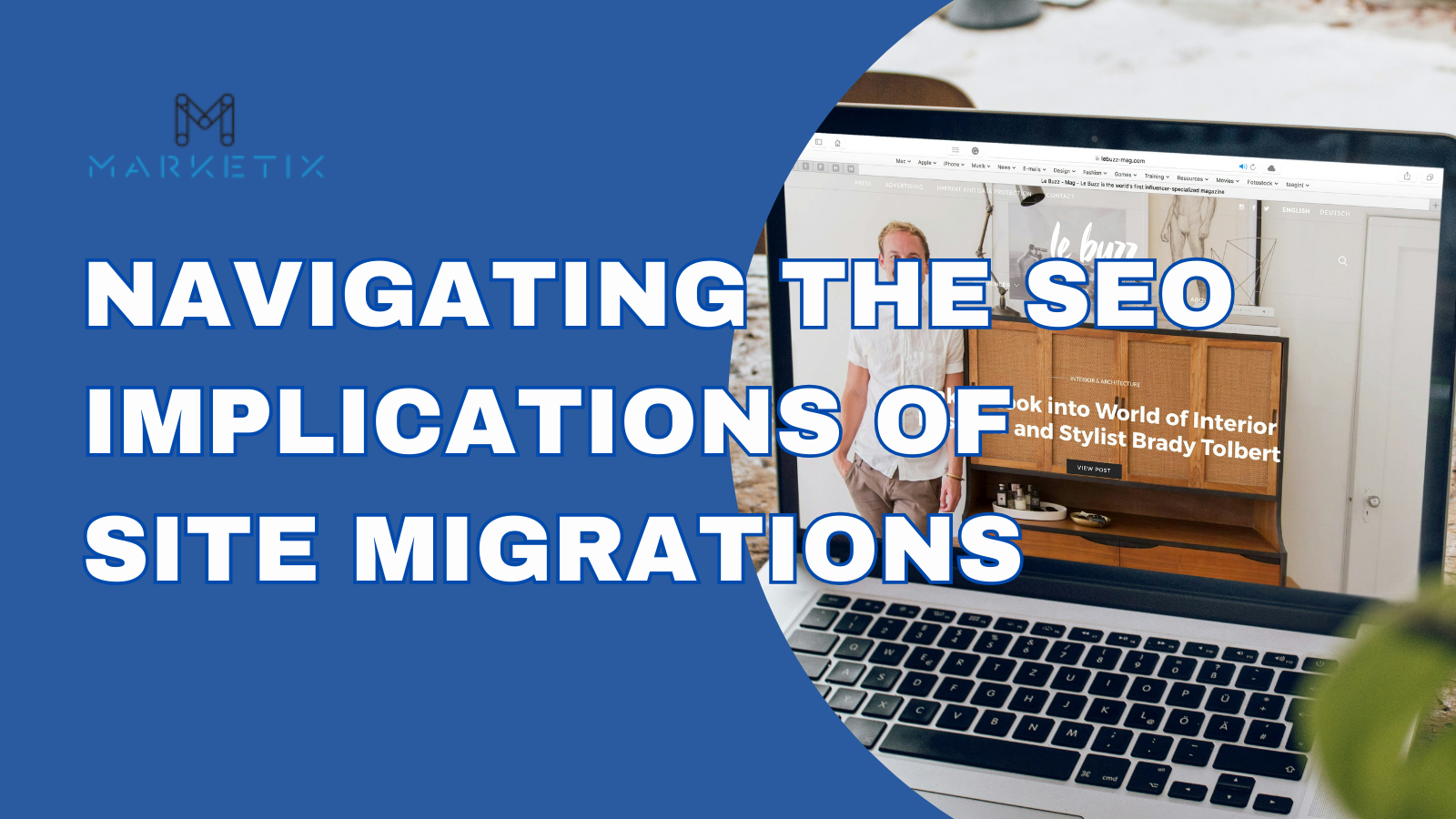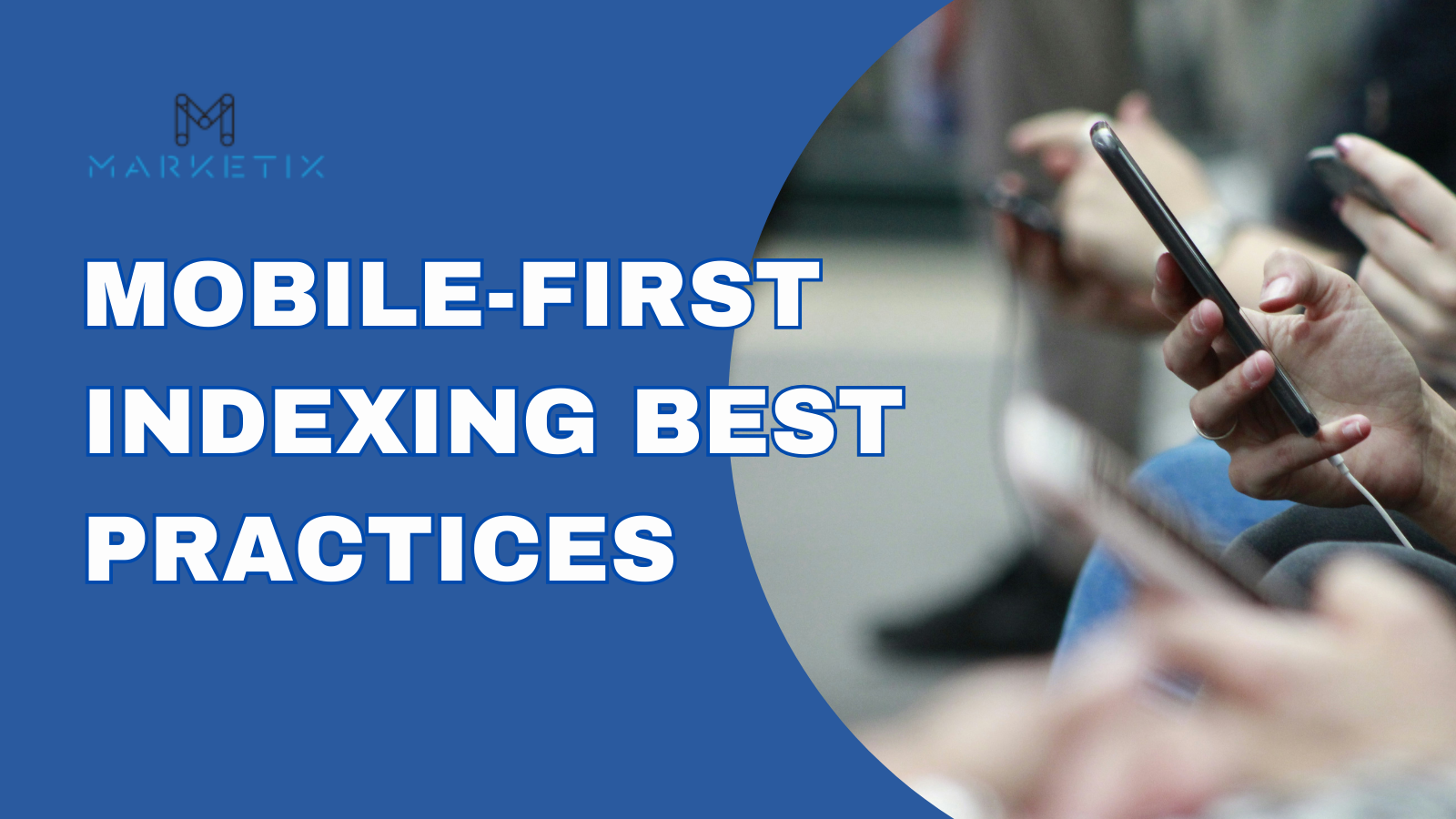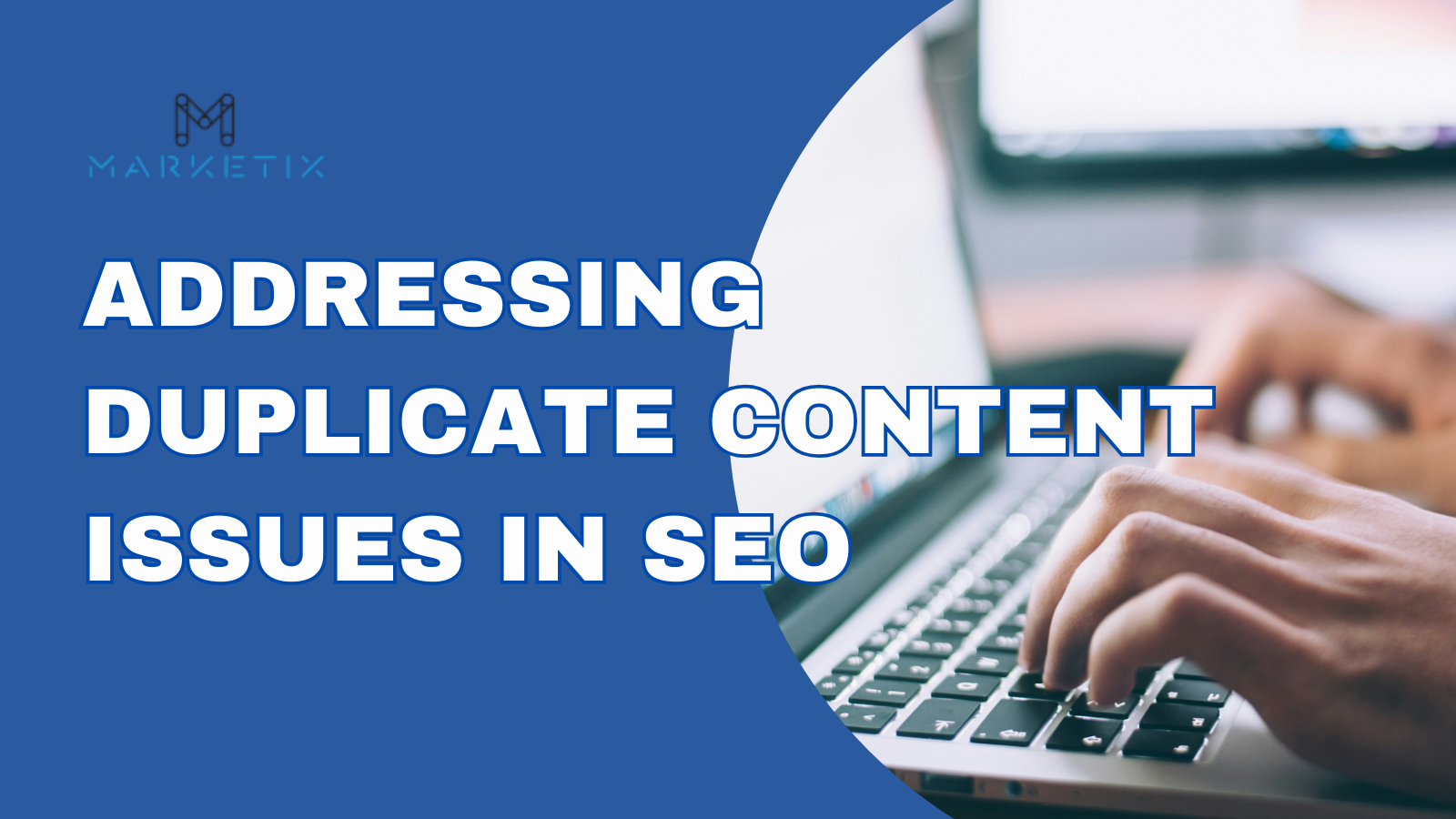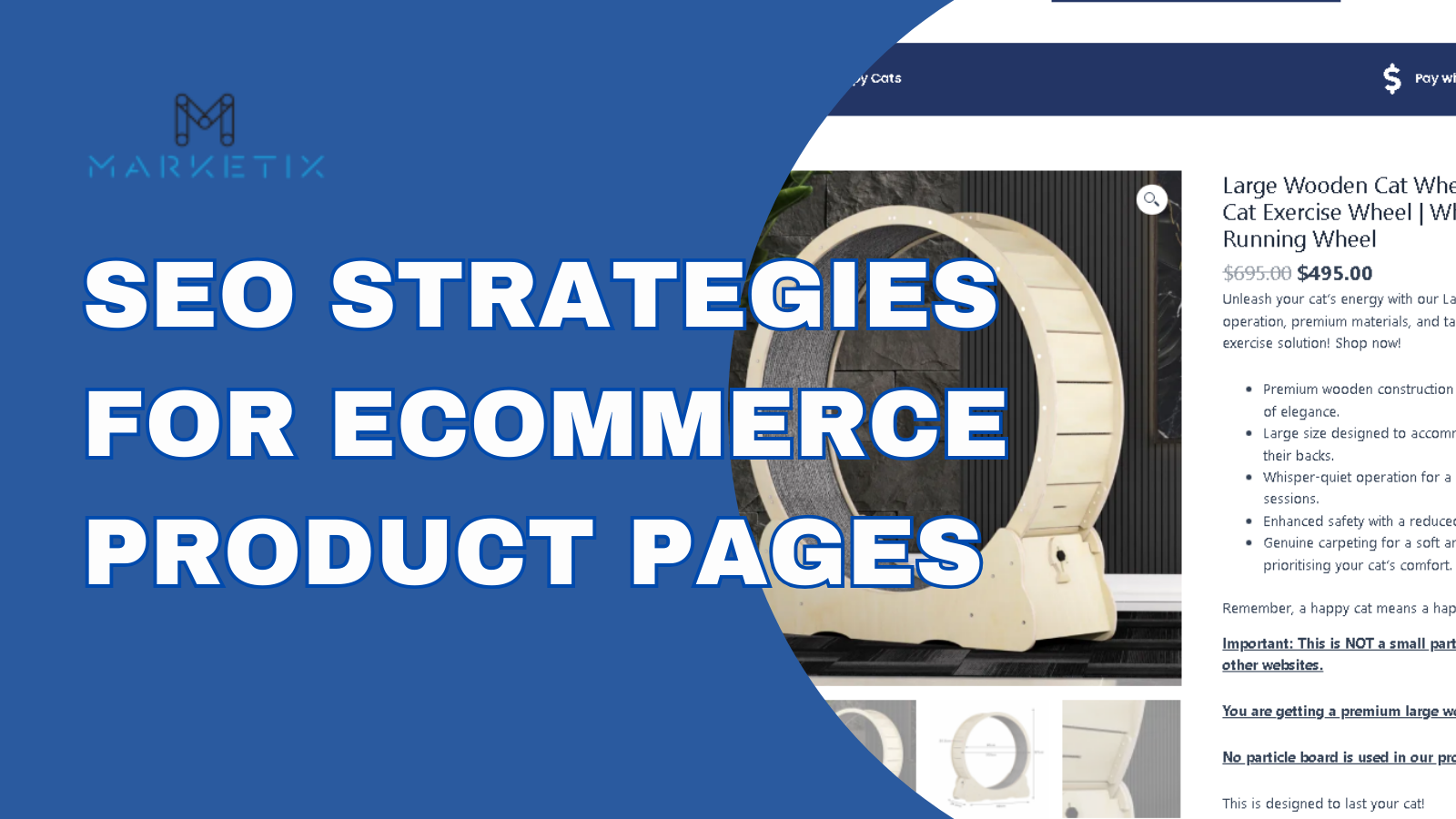- Home
- > The Marketix Blog
- > SEO
What Is SEO and How Does SEO Work?
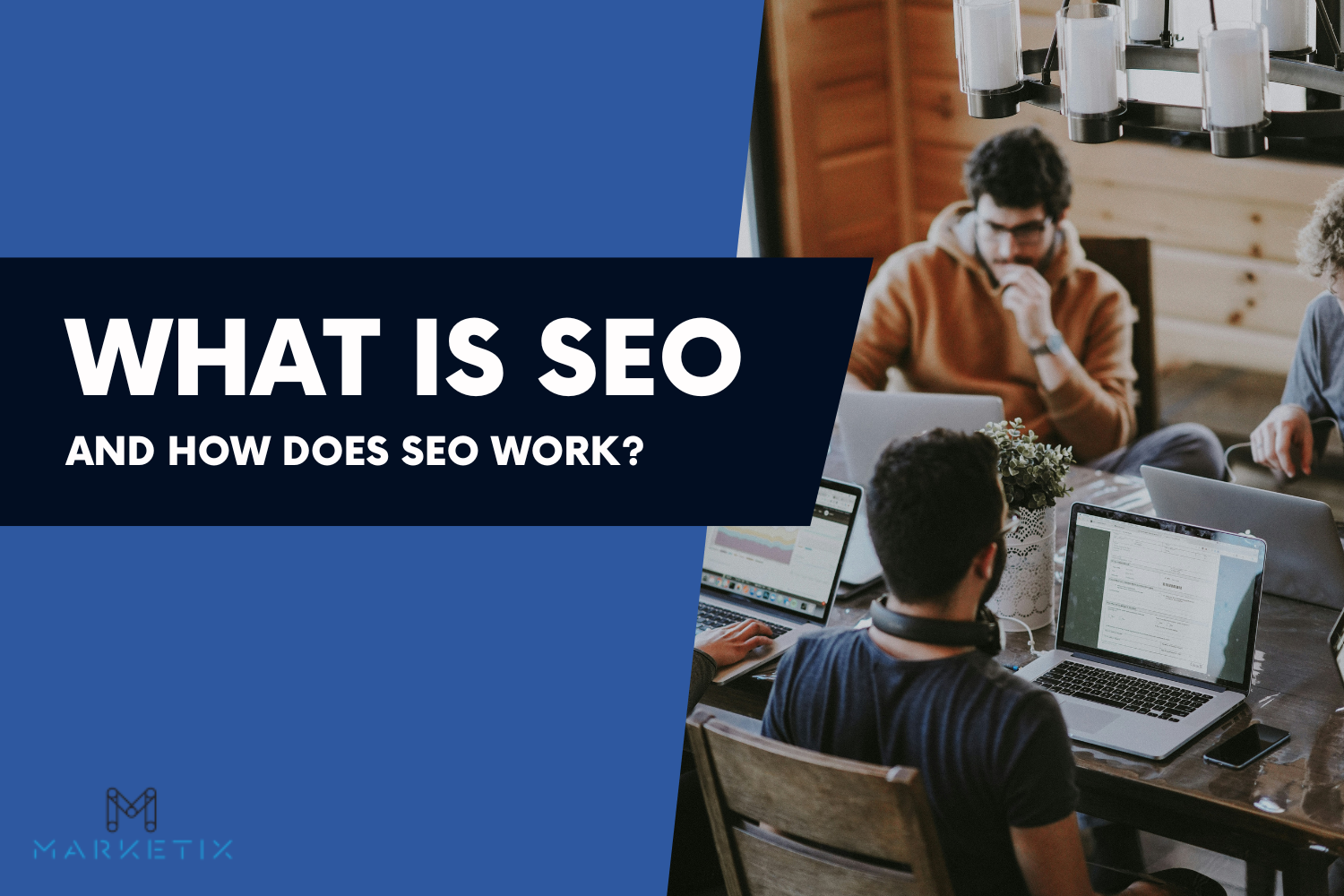
Search Engine Optimisation, or SEO, is the strategic enhancement of a website to improve its position in the organic search results of search engines like Google. Effective SEO involves a myriad of tactics that help a website appear more attractive and relevant to search engines like Google, making it more likely to be found by users.
By optimising everything from the content on the site to the technical underpinnings of the site's architecture, SEO aims to connect your website with the right audience, organically increasing traffic and engagement.
How Search Engines Work?
Short Answer:
Search engines operate by using web crawlers, also known as spiders, to continuously scan the internet for new and updated web pages. These pages are then added to an index—a vast database. The process involves three key stages: Crawling, where the bot discovers and fetches web pages; Indexing, where the content of these pages is analysed and stored in the index; and Serving Search Results, where the indexed pages are retrieved and ranked in response to user queries based on relevance and quality. This sequence allows search engines to provide the most relevant search results to users.
To fully grasp how SEO functions, it's important to understand the underlying mechanics of search engines.
Search engines operate by using automated software, commonly known as web crawlers or spiders, to scan the internet continuously. These crawlers are tasked with finding and indexing new and updated web pages, adding them to a vast database known as an index.
Let's discuss the most well-known search engine of all time, Google. Google's search engine market share is a staggering 91.47% as of January 2024, making it the best example to illustrate how these technologies work.
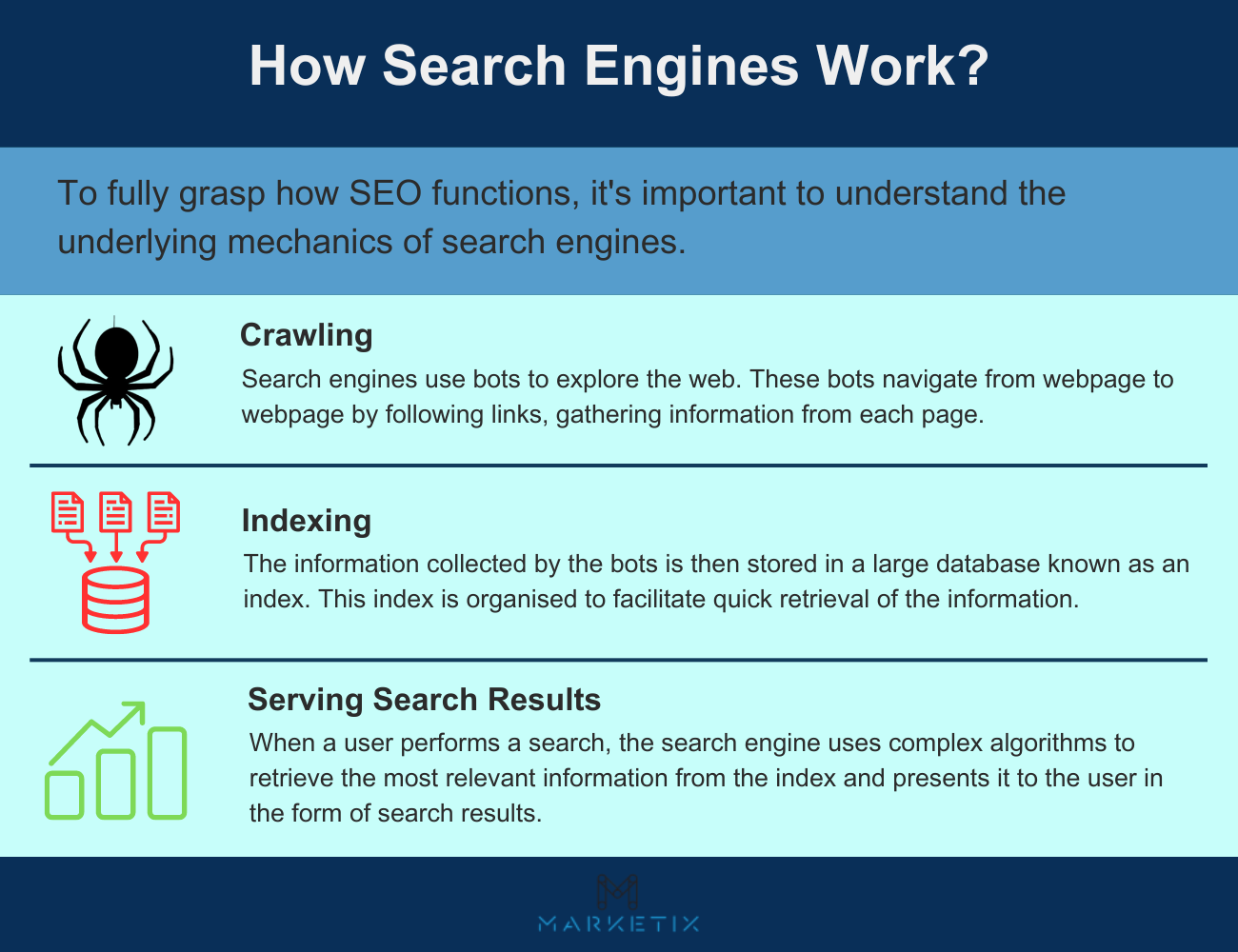
Crawling
According to Google, the crawling stage involves discovering available web pages on the internet. This process starts without a central registry of web pages, necessitating that Google's crawlers search actively for new and updated content.
Google uses a program called Googlebot, which deploys an algorithmic process to decide which websites to crawl, the frequency of crawling, and the number of pages to fetch from each site.
Google emphasises that its crawling process is designed to avoid overwhelming websites, adjusting its crawl rate based on how the websites respond.
Indexing
Once a page is crawled, Google's next task is to understand what the page is about, a process called indexing.
Google analyses the text, images, and video files on the page, using this data to build and update its index.
According to Google, each page is evaluated to determine if it is a duplicate or the canonical version—the version most suitable for display in search results. Issues that can affect a page’s indexing include poor content quality, directives in the robots meta tags, or complex website design that impedes Google’s indexing efforts.
Serving Search Results
When a search query is entered, Google searches its index to find relevant pages.
The relevance is determined by over hundreds of factors which may include the user’s location, language, and device type.
Google clarifies that it does not accept payments for ranking pages higher; such rankings are determined by algorithms aiming to provide the most relevant and high-quality results to users.
Moreover, Google outlines that not every page indexed will appear in search results. Factors leading to exclusion from search results can include low content quality or relevancy to user queries.
Understanding these stages—crawling, indexing, and serving—is essential for webmasters and SEO professionals to optimise their sites effectively for Google Search.
This comprehensive overview of how search engines like Google operate provides the foundation for understanding SEO's role in enhancing the visibility and usability of web content in organic search results.
Why SEO is Important?
Who doesn't want free traffic? Organic search traffic is equivalent to free exposure.
SEO leverages this by optimising your website to capture more of this traffic, which can lead to increased sales and brand authority without the direct cost of advertising.
Significance of SEO in Digital Marketing
SEO is critical because it makes your website more visible, and that means more traffic and more opportunities to convert prospects into customers.
Organic search drives 53% of website traffic, highlighting the substantial role SEO plays in digital marketing strategies.
Impact of SEO on Business Growth
SEO is not just about improving search engine rankings; it's about enhancing the user experience and usability of a website.
Google’s algorithms are increasingly prioritising sites with quality content and good user engagement metrics, such as time on site and bounce rates. Websites that are optimised for SEO bring in more visitors, and those visitors tend to be closer to making a purchase decision than those who are led via paid channels.
Marketix Digital Case Studies Illustrating SEO Success
Learn how we spearheaded transformative SEO campaigns across various industries, achieving remarkable success and driving growth for our clients:
- Uno Home Loans - Dominating the Online Mortgage Broker Market
- Case Study: True Protein - Leading the Fitness Nutrition Category
- Graham and Sons Plumbing - Dominating the Sydney Plumbing Market
These case studies demonstrate how effective SEO can be in different industries, from home loans and health supplements to local plumbing services.
The importance of SEO cannot be overstated. Businesses that effectively adapt and implement strong SEO strategies will not only benefit from increased visibility and traffic but will also strengthen their market position in an increasingly competitive environment.
SEO remains a fundamental component of any successful digital marketing strategy, driving long-term, sustainable growth without the immediate costs associated with paid advertising.
Types of SEO
SEO can be broadly categorised into three main types: technical SEO, on-page SEO, and off-page SEO. Each type addresses different aspects of website optimisation and plays a crucial role in improving a site’s visibility and ranking in search engine results.
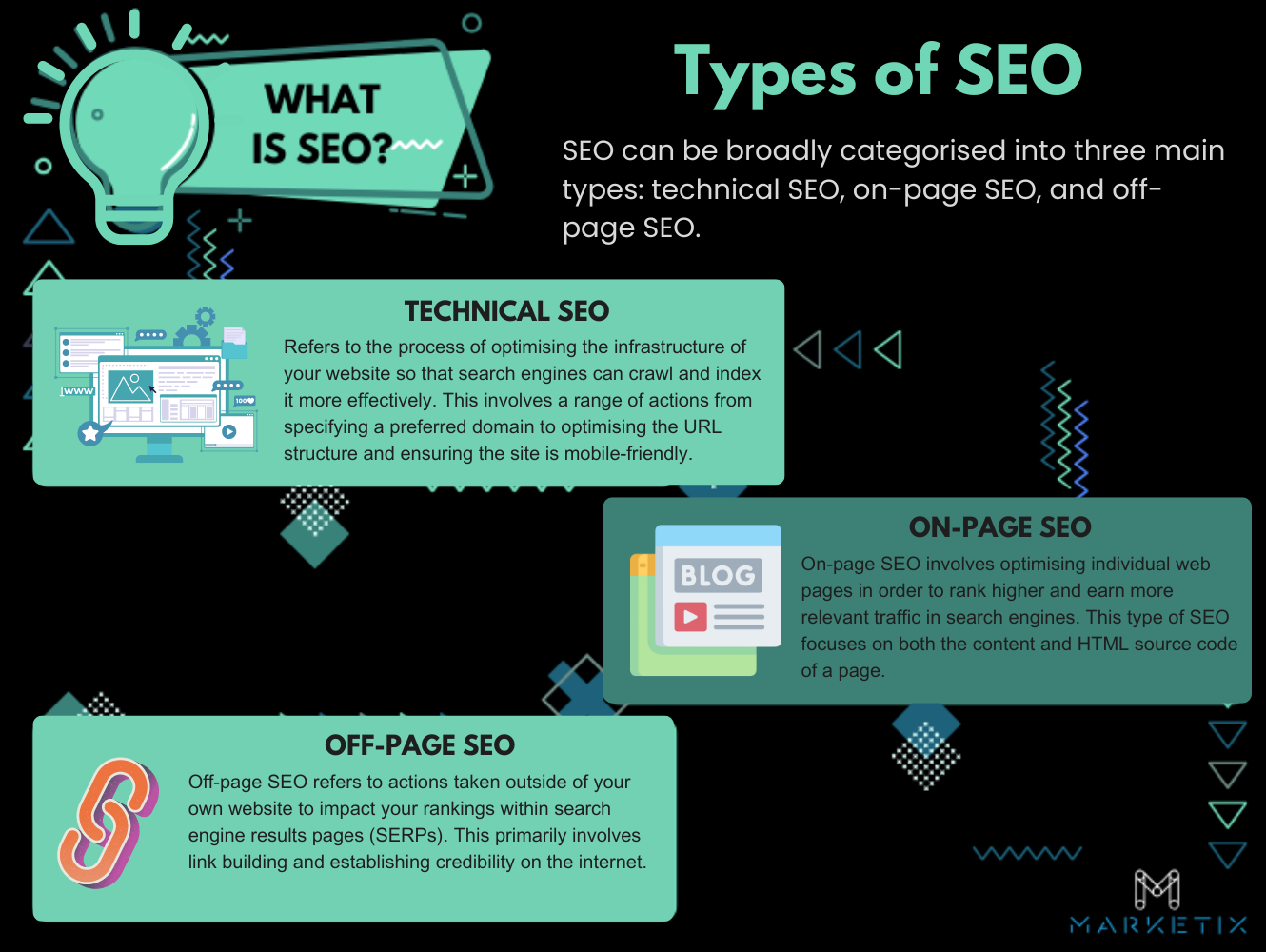
Technical SEO
Technical SEO refers to the process of optimising the infrastructure of your website so that search engines can crawl and index it more effectively.
At Marketix Digital, we adopt a distinctive approach to Technical SEO, termed the C.R.I.C.S Framework, which stands for Crawl, Render, Index, Cache, and Serve.
It’s a methodology that enables us to delve deeply into your website's technical structure, ensuring that every element is optimised for maximum visibility and efficiency in search engine results.
Our C.R.I.C.S Framework begins with the 'Crawl' phase, where we assess how Google's bots interact with your site. We identify and rectify any barriers that could prevent effective crawling, such as server issues, incorrect redirects, or poorly configured robots.txt files.
During the 'Render' phase, we focus on how your site's content is processed and displayed by search engines. Our goal is to make sure that all elements of your website, including JavaScript and CSS, are correctly interpreted by Google.
In the 'Index' stage, our efforts pivot to how your website is catalogued by Google. We always make sure that only the necessary pages are indexed, avoiding duplication or indexing of irrelevant pages. Our strategy involves a thorough review of your site's structure within Google Search Console, applying no-index tags strategically to streamline and enhance your site's representation in search results.
Lastly, the 'Cache' and 'Serve' phases involve ensuring that the most current and accurate version of your site is stored and presented in search results. We closely monitor what Google caches and how it serves your pages in search results. This involves regular checks and adjustments to maintain consistency between your live site and how it is represented in Google's cache, which helps in maintaining a robust online presence.
You can use our C.R.I.C.S Framework if you want to address deep-seated issues that could hinder your website’s performance.
On-Page SEO
On-page SEO involves optimising individual web pages in order to rank higher and earn more relevant traffic in search engines.
- Content Quality and Keyword Optimisation: The quality of your content must align with the search intent behind your audience's queries. High-quality, relevant content that matches the intent of search queries is important for ranking well in search engine results. Your content should deliver real value and incorporate the keywords you aim to rank for. Avoid keyword stuffing; instead, use keywords contextually to maintain the natural flow of information.
- On-page Comparison Analysis with Competitors: Conducting a competitive analysis of the top-ranking pages for your target keywords can provide valuable insights. Analyse these pages to understand what content they include and why they rank well. This analysis will guide you in crafting your content and SEO strategy to compete effectively.
- Comprehensive On-page SEO Checklist: On-page SEO includes a wide array of elements beyond the few discussed here, such as internal linking, external linking, metadata optimisation, image optimisation, URL optimisation, page speed improvement, and more. Each element of the on-page SEO checklist—from title tag to fixing broken links—plays a role in enhancing your page's search engine visibility and user experience. It's essential to systematically address these elements to ensure comprehensive optimisation of your website.
Off-Page SEO
Off-page SEO refers to actions taken outside of your website to impact your rankings within search engine results pages (SERPs). This primarily involves link-building and establishing credibility on the internet.
- Building Quality Backlinks: Backlinks are a major component of Google’s ranking algorithm. Links from reputable sites can significantly boost your site’s credibility and authority. However, it's important to focus on quality over quantity, as backlinks from trusted, authoritative websites are valued more highly than those from lesser-known sources.
- Influence of Reviews and Mentions: Another critical aspect of off-page SEO is managing your brand’s reputation through reviews and mentions on third-party sites and aggregators. What other websites say about your brand can influence both user perceptions and search engine evaluations. Positive reviews and mentions on reputable sites can bolster your site's authority and aid in achieving better SERP positions.
Each type of SEO is important for a website’s overall search engine performance. By optimising technical aspects, enhancing on-page content, and building authority through off-page efforts, businesses can improve their visibility and positioning in SERPs, driving more organic traffic and engaging potential customers more effectively.
SEO Specialties
As the field of SEO expands, specialised branches have evolved to address the unique needs of different types of businesses and industries.
These specialities include Enterprise SEO, B2B SEO, Shopify SEO, eCommerce SEO, Technical SEO, and more, each tailored to specific market demands and challenges.
Enterprise SEO
For large corporations with extensive digital footprints, Enterprise SEO is indispensable.
For large corporations that manage extensive digital footprints. This specialised approach focuses on maintaining efficiency in managing expansive content and complex website structures, making sure that large corporations remain agile and competitive in organic search results.
The strategy encompasses comprehensive keyword research, sophisticated link-building tactics, and regular content audits.
By prioritising these elements, Enterprise SEO helps large organisations optimise their web presence across numerous pages and diverse business units.
B2B SEO
When it comes to B2B marketing, the stakes are high.
The target audience here involves decision-makers who require detailed, authoritative content before making purchase decisions.
B2B SEO specialises in crafting content that not only ranks well but also positions the company as a leader in its industry. This involves a keen understanding of the business landscape, competitive keyword research, and creating content that aligns with the distinct phases of the business buyer's journey.
Shopify SEO
Shopify stores represent a unique challenge in the SEO world due to their templated nature and the competitive e-commerce environment.
Optimising a Shopify site involves not just general SEO practices but also specific interventions tailored to the platform, including structural enhancements, speed optimisation, and the strategic use of Shopify's in-built SEO-friendly features.
eCommerce SEO
Optimising for eCommerce involves a deep focus on product listings, customer reviews, and user experience.
eCommerce SEO aims to enhance product visibility and drive conversions by ensuring that product descriptions are keyword-rich and persuasive, metadata is optimised, and all content is structured to facilitate easy purchasing decisions. Additionally, it also heavily emphasises mobile optimisation and fast loading times, critical factors in retaining customer interest online.
Technical SEO
Technical SEO is the backbone of any optimisation strategy, focusing on the website's technical elements that influence search rankings.
Technical SEO is crucial for websites to maximise their potential in search rankings by addressing foundational web development issues that may be impacting Google's ability to crawl, render, index, cache, or serve your pages
Simple Yet Powerful SEO Process
This step-by-step guide outlines a straightforward yet effective SEO process that can be applied to any website.
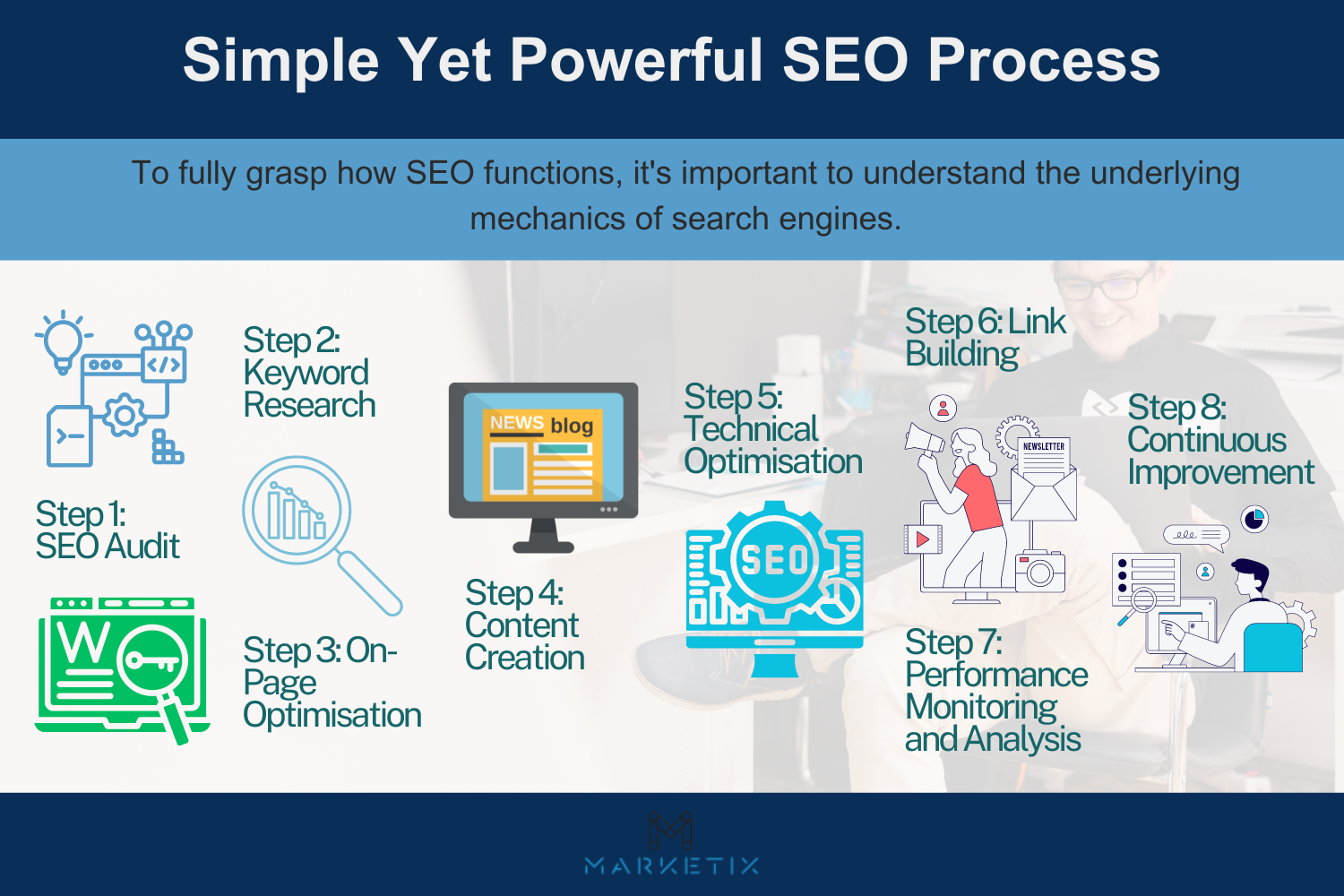
Step 1: SEO Audit
Begin with a comprehensive audit of your website to identify areas of improvement.
Go over technical SEO, on-page elements, content quality, and the site’s backlink profile.
Tools like Google Search Console, Ahrefs, Screaming Frog, and various SEO audit tools can provide insights into issues like slow loading speeds, crawl errors, and duplicate content.
This initial step helps set the baseline for your SEO efforts and prioritise actions.
Step 2: Keyword Research
Identify the keywords that your target audience is searching for.
Utilise tools like Google Keyword Planner, Ahrefs, or SEMrush to find relevant keywords with good search volume and achievable competition.
Focus on a mix of short-tail and long-tail keywords to balance immediate results and long-term opportunities.
Step 3: On-Page Optimisation
Optimise the content of your website to make it more appealing to search engines and users.
Make sure that each page has a unique and informative title, meta description, and URL structure.
Additionally, all images should have alt-text descriptions that also incorporate relevant keywords. On-page content should be engaging, informative, and provide value to readers, while naturally incorporating the identified keywords.
Step 4: Content Creation
Develop high-quality content that addresses the needs and questions of your target audience.
Content should not only focus on what your audience is currently searching for but also anticipate future queries and provide comprehensive answers.
Consistently creating relevant content that engages and educates your audience will establish your site as an authority and improve its ranking in search results.
Step 5: Technical Optimisation
You need to make sure that your website’s backend is optimised for search engines. This includes improving site speed by optimising images and leveraging browser caching.
Your website should be mobile-friendly, as mobile usability is a significant factor in Google rankings. Implement structured data markup to help search engines understand the content of your site better and enhance the appearance of search results with rich snippets.
For this part, we recommend going over our C.R.I.C.S Framework guide.
Step 6: Link Building
Build a strong backlink profile by acquiring high-quality links from reputable websites. This can be achieved through various tactics such as guest blogging, partnerships, and digital PR.
Remember, the quality of links is more important than quantity. A few high-authority backlinks can do more for your SEO than dozens of low-quality links.
Step 7: Performance Monitoring and Analysis
Regularly monitor your website’s performance using tools like Google Analytics and Google Search Console—track metrics such as organic traffic, ranking for targeted keywords, and conversion rates.
Analyse these metrics to understand what’s working and what isn’t. This continuous feedback loop allows you to refine your SEO strategy and make informed decisions to improve your website’s search engine performance.
Step 8: Continuous Improvement
SEO is not a one-time task but an ongoing process. The search engine competition is constantly changing, with new algorithms and competitor strategies emerging. Continuously update your SEO practices based on performance data, industry trends, and new techniques to maintain and improve your search rankings.
Important Notes on SEO
Here are some important considerations every SEO practitioner should keep in mind:
SEO is an Ongoing Process
SEO is not a set-and-forget strategy. It is constantly evolving, with new technologies, user behaviours, and competitive strategies emerging regularly.
Websites must continuously optimise and update their SEO tactics to remain competitive in search rankings. This involves regularly revisiting your SEO strategy, conducting new keyword research, updating content, and staying abreast of SEO best practices.
Google Search Engine Algorithm Updates
Google frequently updates its algorithms to improve the relevance and quality of search results.
One of the significant recent updates was the March 2024 Core Update, which emphasised Google's ongoing commitment to combating spam and manipulative content practices.
According to the update documentation on Google's developer blog, this update aimed to enhance the detection and penalisation of spammy content, thereby promoting more useful and trustworthy content for users.
Websites adhering to Google’s SEO guidelines and focusing on high-quality content were likely rewarded, whereas those engaging in manipulative practices faced penalties in their rankings.
Marketix SEO Resources
For further reading on SEO and related topics, consider exploring these detailed articles from Marketix, which offer in-depth insights and strategies to enhance your SEO efforts:
Learn about the processes involved in managing SEO strategies, including planning, implementation, and monitoring of SEO campaigns.
Understand the timeline for SEO campaigns and what factors influence the time it takes to see tangible results.
The importance of backlinks in SEO, how they improve site authority and methods for acquiring quality links.
Understanding the intent behind searches can dramatically improve the effectiveness of your SEO and content strategies.
A deep dive into how Google ranks websites and the various systems and algorithms that determine search rankings.
Strategies for optimising your website for different geographic and language markets to attract international traffic.
Frequent SEO errors and how to avoid them to improve your overall SEO performance.
Understand the role of robots.txt in SEO, how it directs search engine crawlers, and best practices for its use.
Get tips on selecting the right SEO agency for your business needs, including what questions to ask and what criteria to consider.
These resources provide a wealth of information and practical tips to help you understand and implement effective SEO strategies tailored to your business objectives.
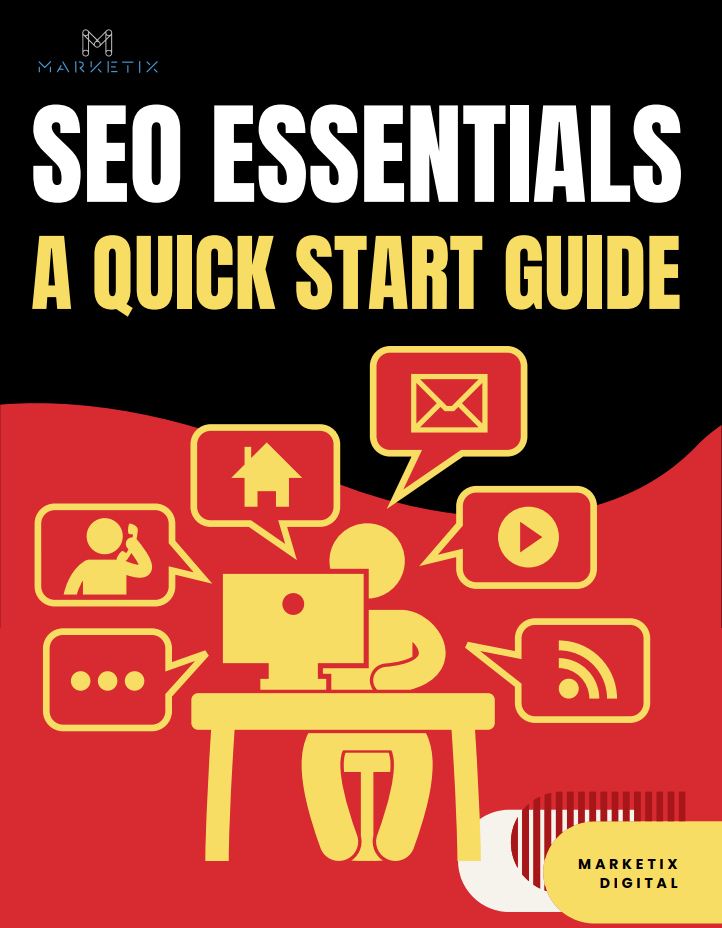
Free Download SEO Book
Download our 24-page SEO book to learn:
- How SEO Really Works
- How to Rank #1
- Content & SEO
- Choosing an SEO Agency
Thank you!
You have successfully joined our subscriber list.



